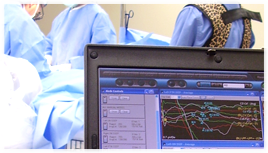What is IONM?
 IONM assists surgeons and protects patients by continuously monitoring your central and peripheral nervous system(s). The use of IONM can help your surgeon immediately identify surgical events that could lead to nerve damage. IONM is also useful in helping your surgeon identify nerves that may be otherwise obscured by surrounding tissue.
IONM assists surgeons and protects patients by continuously monitoring your central and peripheral nervous system(s). The use of IONM can help your surgeon immediately identify surgical events that could lead to nerve damage. IONM is also useful in helping your surgeon identify nerves that may be otherwise obscured by surrounding tissue.
- IONM is medically recognized as an important tool for surgical procedures that place the central and/or peripheral nervous system(s) at risk for injury (harm resulting from medical treatment). The surgical patient’s brain, spinal cord, and nerves are monitored continuously for the duration of the surgical procedure.
- IONM can decrease the risk of injury as the surgeon may alter his or her surgical technique should an IONM interpretation detect an adverse change in the peripheral and/or central nervous system(s). In addition, injury to the central nervous system or peripheral nerves may come as the result of the surgical patient simply resting incorrectly or being positioned incorrectly on the surgical table.
- Alterations in surgical technique, and/or repositioning the patient on the surgical table based on IONM interpretations, have been shown to reduce the risk of temporary and/or permanent post-operative neurological deficits.
- IONM provides improved anatomical identification for the surgeon which can decrease overall surgery duration, which in turn decreases overall patient exposure to anesthesia while keeping hospital costs down.
- Surgeons utilizing IONM offer their patients reassurance that every effort is being made to increase the likelihood of a positive surgical outcome.
How Does IONM work?
IOM works through monitoring electrical impulses traveling through the central nervous system. The impulses are measured with electrodes placed on various areas of the body such as the wrists, ankles, and scalp. Additionally, muscle groups specific to the type and location of the nerve(s) in question are monitored for electrical activity. The function of your central nervous system is assessed by detecting any changes in the electrical impulses or the electrical activity in the muscles. A specially designed computer system, operated by a trained technologist, records, and displays the data collected by the electrodes. This information is instantly available to both the surgeon and an interpreting physician MD/DO trained in neurophysiology; if changes do occur your surgeon can take action immediately.
Who requested IONM for my surgery?
According to the type and complexity of your particular surgery the surgeon contacts Synaptic Resources and personally requests IONM.
What are the Risks Associated with IONM?
There are risks associated with IONM. If you have an implanted cardiac device, implanted metal in your skull from previous neurosurgery, or a history of seizures; please alert your surgeon’s office and your surgical team prior to surgery. There is also chance of minor bleeding and infection from the placement of subdermal electrodes placed on your body. IOM reduces the risk but does not eliminate the possibility of temporary or permanent neurological deficits resulting from your surgery. Consult with your surgeon to discuss the risks of your particular procedure.
If I still have questions about IONM, whom should I contact?
Please contact our corporate office at 918-743-5552 or email us at info@synapticiom.com
